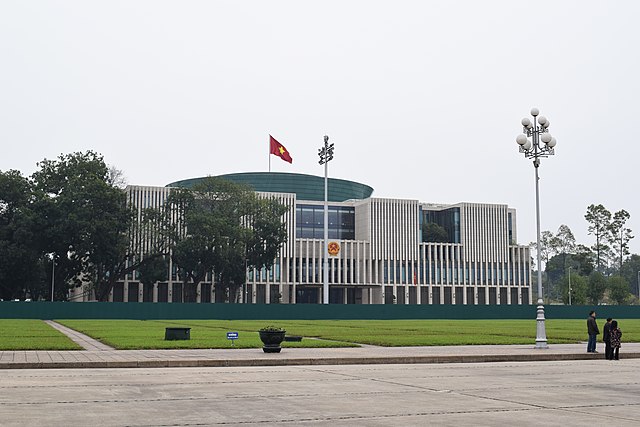By Jean-Philippe Eglinger, external contributor for Asia Centre.
Introduction
Following the end of the 13th Congress of the Vietnamese Communist Party (January 25th, February 2nd, 2021), the western international press unanimously pointed out main characteristics of Vietnam’s current situation: outstanding management of the Covid sanitary crisis, great economic achievement considering the period and strengthening of inner pressure on opponents, mainly young bloggers[1][2][3] as well as strong need for reforms[4] in spite of a unchanged political situation[5].
Few of the articles were devoted to a deep analysis of the global economic objectives set by the Central Committee and the way to achieve them.
This brief note aims at presenting a global view of the economic and social objectives set by the Congress for the next mandate, the still current difficult economic situation Vietnamese have to face with and to sketch out solutions that could be put in place in the future.
But more than that, the goal of this present note besides providing a first snapshot of the current situation aims at starting a series of others articles in the future that will take a deeper analysis into the different tackled points of this current article.
Congress and Economic objectives set by the congress for the next mandate
In fact, as mentioned by Hung Nguyen from George Mason University[6], “since 1991 despite intense internal discussion […] there were few leaks, no petitions, no open letters to leaders and few rumors, innuendoes or heated exchanges on social media. The party proved to be in firm control of the situation”.
It is true that the process of shaping out of the “leading quarter” of the new mandate has been publicly revealed by the Vietnamese version of the BBC on January 8th[7]. At that time many observers found it strange to discover that Mr. Nguyen Phu Trong could be appointed again as General Secretary considering his age and health. No internal “counter-forces” were apparently strong enough to change this role distribution. Therefore, some observers stated that this “result” was “the art of not changing anything[8]“.
However, some inner-observers stated that the anti-corruption campaign launched by Mr. Trong resulted in the fact that no “big money” was flooding in anymore hindering the capacity for outsiders to buy “support” for the election. Others analysts stated that “Commentary on the Communist Party of Vietnam’s 13th Party Congress has mostly focused on General Secretary Nguyen Phu Trong’s selection for a third term. But it is the selection of Vietnam’s prime minster, which Congress rankings suggest will be Pham Minh Chinh, that could have a greater impact on the future of the Vietnamese political system at the national and local levels[9]”
But instead of trying to describe an event on which very few details emerged, let’s consider now the public declarations that have been made from this Congress.
Resolutions of the XIII National Congress of the Party[10] have clearly set economic and social goals. From an economy perspective, it is stipulated that “the 5-year average economic growth (GDP) is about 6.5-7%/year. By 2025, GDP per capita will be around USD 4,700-5,000; the contribution of total factor productivity (TFP) to growth is about 45%; the average social labor productivity growth rate is over 6.5%/year; […]; the digital economy is about 20% of GDP. Social: By 2025, […]; rate of trained workers is 70%; […] “.
It is clear that the targets set are ambitious. Speaking alone, the objective consisting in doubling the GDP per capita within a 5-year period will be a huge challenge for the Vietnamese authorities in a changing world where the yesterday’s recipes might not be valid tomorrow. In fact, according to economist expert specialist of Vietnam, in order to reach a 7% GDP increase Vietnam needs to inject 28 to 30% of GDP per year in the economy (roughly USD90 billion). How the current business model of Vietnam might be affected in the coming years? And what will be the Vietnamese authorities answer to this challenge.
Difficult and slow economic recovery
Vietnam has been rightly praised as being one of the most successful countries to manage to maintain a positive GDP increase during the Covid pandemic in 2020. However, the current situation in Vietnam is still sluggish. Foreign direct investment in the first two months fell 15.6 percent year-on-year to reach $5.46 billion, according to the Foreign Investment Agency[11]. Even if Vietnam is still considered as a privileged destination in the “1+1” strategy carried out by international groups.
The investment poured in the manufacturing sector amounts to over $3 billion and the power sector around $1.44 billion and property $485 million.
Japan was the leading investor with $1.64 billion, followed by Singapore and South Korea. However, Vietnam was retrograded as choice of investment expansion for Japanese companies as stated in a recent survey. 46.8% of Japanese companies surveyed that have invested in Vietnam said they will increase their investments over the next two years, down 17.1% from the 2019 survey[12].
Considering that Vietnam is striving to attract foreign investment to fulfill its economic goals[13], this situation is showing an external dependence to meet internal objectives. Knowing that the current economic development of Vietnam is still based on and export-oriented model which heavily relies on the foreign sector which is operating in devoted Industrial Zone to proceed and re-export products that have been assembled in the country. In fact, according the Customs of Vietnam, in 2020, as from November 15th, 2020; the Foreign Direct Investment companies accounted for 70% of Vietnam’s exports and 63% of imports of the country[14].
In terms of new companies’ creation, according to the Department of Business the number of newly established enterprises in the first two months of the year was 18,129, a decrease of 4% compared with the same period in 2020. Also, according to this Department, in the first two months of the year, 33,611 enterprises withdrew from the market, up 18.6% over the same period in 2020, including: 21,636 enterprises registered which will suspend business for a definite period, 8,380 businesses suspended operations to wait for dissolution and 3,595 enterprises completed dissolution procedures[15].
Some sectors which were seen as “economic development engines” for Vietnam are still deeply affected such as tourism[16], hotels[17], catering… And the real estate sector, which has a negative impact of the banking system which is still fragile with a soaring bad debt situation[18]. And on the purchasing power of the Vietnamese population[19] as more than 31 million employees have had to suffer from the Covid effect on the economic activity of Vietnam[20].
If we add to these above-mentioned points that Vietnam is under investigation by the US Government of manipulating its money to favour its export[21], it let few rooms for Vietnam to readjust its future economic development to meet the target set by the 13th Party Congress…
Solution proposed: from quantity to quality
Being under pressure on the export front both due to the increasing competition of other countries and to Vietnam’s heavy dependence to three main markets (the United States, The European Union, China…), the authorities tend to focus and others “engines” to spur the economic development and tend to move from a “quantitative approach” to a more oriented “qualitative approach” leaded by the Vietnamese “private” sector[22] leaded by strong corporations[23]and aiming at developing the national consumption to prevent from the next potential unwanted impacts[24].
- Clear objective to continue developing the quality instead of the quantity
As stipulated in the Resolutions of the 13th Congress, concerning the ” Development orientation of the country in the period 2021 – 2030″[25] it is clearly stated that Vietnam need to “create a breakthrough in fundamental and comprehensive innovation in education and training, develop high-quality human resources, and attract and appreciate talents ; promote research, transfer and powerful application of achievements of the Fourth Industrial Revolution in all fields of social life, focusing on a number of key industries and fields with potentials and advantages to drive growth in the spirit of catching up, moving forward and surpassing in some areas compared to the region and the world”.
This come in the prolongation of Project 844 set by the government in May 2016 which was aiming at defining a legal framework that frames and supports the establishment of an “ecosystem for the development of innovative start-ups to boost innovation in Vietnam by 2025” in order to spur Vietnamese innovation ecosystem[26] and deploy the Fourth Industrial Revolution.
- Develop Start-ups ecosystem and 4th Industrial Revolution
According to a recent article of Alexander L Vuving[27], “During 2020, 13,000 new start-ups[28] joined an existing 45,000 businesses in Vietnam’s budding digital economy. According to an analysis[29] of 90 economies, Vietnam is — along with Azerbaijan, Indonesia, India and Iran — behind China only in its digital evolution momentum”.
This momentum is here to stay and Vietnam is recognized as one the most dynamic countries in the region in terms of development of start-ups. Year 2019, before the Covid sanitary and economic crisis, was considered a great year for technology investment and start-ups in Vietnam. Around $861 million have been invested in 123 start-ups deals. And it is noticeable that the investor interest is shifting to emerging industries such as HR technology, real estate technology, while traditional industries such as retail still “dominate” investment.
If we take the key Fintech sector alone, this market has almost tripled in size between 2017 and 2020, growing from 44 startups in 2017 to now 121 start-ups[30] helping the economy to find payments solutions.
- EVFTA or RCEP
The EVFTA (EU – Vietnam Free Trade Agreement) between Vietnam and the European Union – EU was officially signed on June 30, 2019, coming into force on August 1, 2020. This agreement will allow Vietnam to access a 508 million people market worth 20% of the world GDP (18 trillion USD). The RCEP (Regional Comprehensive Economic Partnership) is the largest free trade agreement in the world backed by China, including 10 ASEAN countries, China, Japan, South Korea, Australia and New Zealand, with total GDP of 15 countries more than 26 trillion USD, accounting for nearly 30% of the world’s GDP, not to mention covering one third of the global population.
Vietnam lies in a key position to benefit from these two economic blocks. With specific access requirements request from the European Union, mainly link to environmental, labor and IP protection standards. A way for Vietnam to climb up the value chains for its products and retain more “Vietnamese” added value than this is the case today, notably in the Information and Technology sector, the agri-business sector… And therefore, meet the target set by the Vietnamese authorities.
Conclusion
The emergence of a “renewed” quartet at the top of the Communist Party tends to show continuity in the economic policy that will be carried out in the next mandate. However, the lingering nomination at the key responsibilities in the government also indicates that “fights” are still occurring to keep a balance among the newly appointed teams.
In spite and independently of this renewal, Vietnamese authorities are facing tough times ahead in terms of economic development[31] in order to meet the targets reaffirmed during the 13th Party Congress.
Mainly based on an export-oriented model fueled by foreign investments, the Vietnamese economy needs to move up the value chain in order to slowly prevent itself from “unwanted” external shocks such as indirect effects of the Covid pandemic for instance.
The authorities made it clear that the goal was now to focus more and more on a qualitative economic development rather than a quantitative approach based on the development of innovation ecosystem to spur the development of the “private” sector and therefore improve the efficiency of its economic system. Does it mean the confirmation a new recently emerged “business model” for Vietnam?
Moreover, by recently joining two main Free Trade Agreements, Vietnam tends to show that his strategy will be to diversify his export market to be less reliant on the current three main markets such as the United States, the European Union, and China… One can then wonder on which side EVFTA or RCEP Vietnam will balance in the future?
[1] https://www.lesechos.fr/monde/asie-pacifique/le-double-visage-du-vietnam-1283830
[2] https://www.challenges.fr/monde/le-vietnam-a-accentue-sa-repression-avant-le-congres-du-parti-au-pouvoir_746592
[3] https://www.lepoint.fr/monde/le-vietnam-renouvelle-ses-dirigeants-sur-fond-de-repression-accrue-25-01-2021-2411007_24.php
[4] https://foreignpolicy.com/2021/02/10/vietnam-communist-party-congress-reform-coronavirus-economy/
[5] https://theconversation.com/xiii-congres-du-parti-communiste-du-viet-nam-lart-de-ne-rien-changer-154662
[6] https://www.eastasiaforum.org/2021/02/25/vietnams-unresolved-leadership-question/?utm_source=rss&utm_medium=rss&utm_campaign=vietnams-unresolved-leadership-question
[7] https://www.bbc.com/vietnamese/vietnam-55604797
[8] https://theconversation.com/xiii-congres-du-parti-communiste-du-viet-nam-lart-de-ne-rien-changer-154662
[9] https://www.eastasiaforum.org/2021/03/01/pham-minh-chinhs-potential-to-shape-vietnams-political-system/?utm_source=rss&utm_medium=rss&utm_campaign=pham-minh-chinhs-potential-to-shape-vietnams-political-system
[10] https://daihoi13.dangcongsan.vn/tu-lieu/van-ban-chi-dao-huong-dan
[11] https://baodautu.vn/infographic-2-thang-dau-nam-2021-thu-hut-fdi-dat-546-ty-usd-m138513.html
[12] https://www.thesaigontimes.vn/313621/viet-nam-bi-tut-hang-trong-lua-chon-mo-rong-dau-tu-cua-doanh-nghiep-nhat.html
[13] https://tapchitaichinh.vn/nghien-cuu-trao-doi/thu-hut-fdi-mui-giap-cong-quan-trong-de-phuc-hoi-nen-kinh-te-322915.html
[14] https://www.vietphapstrategies.net/blog/article/show/16
[15] https://thuongtruong.com.vn/news/hon-33-600-doanh-nghiep-rut-lui-khoi-thi-truong-trong-2-thang-dau-nam-47631.html
[16] Before the Covid pandemic, the tourism sector amounted to roughly 7% of the GDP.
[17] https://vtc.vn/khach-san-o-da-nang-vo-tran-thi-nhau-ban-thao-cat-lo-hang-chuc-ty-dong-ar597497.html
[18] https://nhadautu.vn/gap-go-thu-tu-ts-le-xuan-nghia-hay-nhin-vao-con-so-thuc-chat-cua-no-xau-d48816.html
[19] https://www.thesaigontimes.vn/313767/thi-truong-sau-tet-2021-co-dau-hieu-suc-mua-thap.html
[20] https://www.gso.gov.vn/du-lieu-va-so-lieu-thong-ke/2021/01/bao-cao-tac-dong-cua-dich-covid-19-den-tinh-hinh-lao-dong-viec-lam-quy-iv-va-nam-2020/
[21] https://www.nytimes.com/2020/12/16/us/politics/trump-vietnam-switzerland-currency-trade.html
[22] https://www.thesaigontimes.vn/314306/sao-chi-lam-to-cho-%E2%80%98dai-bang-ngoai-ma-bo-quen-dai-bang-noi.html
[23] https://tuoitre.vn/thu-tuong-den-2045-se-xuat-hien-cac-tap-doan-khong-lo-mang-ten-viet-nam-20210306192342934.htm
[24] https://nhandan.com.vn/kinh-te/tieu-dung-la-dong-luc-thuc-day-tang-truong-607802/
[25] Nghị quyết Đại hội đại biểu toàn quốc lần thứ XIII của Đảng
[26] https://centreasia.eu/produit/lecosysteme-de-linnovation-et-de-la-creation-dentreprises-au-vietnam-jean-philippe-eglinger/
[27] https://www.eastasiaforum.org/2021/02/27/where-to-now-for-vietnam-after-trong/
[28] https://cafef.vn/khong-make-in-vietnam-thi-chung-ta-khong-the-di-ra-the-gioi-20201223174302373.chn
[29] https://hbr.org/2020/12/which-economies-showed-the-most-digital-progress-in-2020
[30] https://www.vir.com.vn/vietnam-fintech-startup-go-from-44-in-2017-to-121-81170.html
[31] https://centreasia.eu/vietnam-les-autorites-face-aux-enjeux-economiques-et-sociaux-de-lapres-covid/





